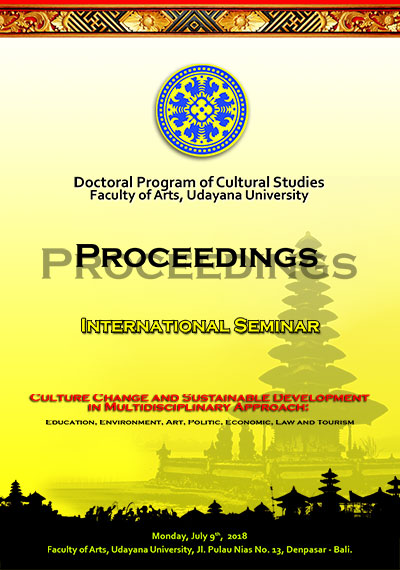CREATIVE SIGNAGE FOR COMMERCIAL BUILDING IDENTITY IN DISRUPTIVE ERA, AS A STRENGTHENING CHARACTER OF LOCAL ARCHITECTURE IN DENPASAR, BALI
Abstract
The Denpasar city as the provincial capital of Bali. The architecture, like the existing buildings along the road in Denpasar City are mostly used as commercial functions, such as Rumah Toko, Rumah Kantor, café, restaurant, shop, boutique, warung, modern mini supermarket, etc. The face of this building is varied and not reflects the Balinese architecture. One of the characteristics of Denpasar architecture is the use of red brick material and pepalihan with red brick forms. The pepalihan is front and back plotting as a pattern on a pair of bricks. Creativity and new ideas can be applied in building facades, such as signage, nameplate, and certain types of materials and engravings, with their own uniforms for each different building function. The design use local materials, with the pepalihan bebadungan, and affordable price, designed with uniform size, inscribed Balinese script or Aksara Bali and writing the café or restaurant name. This idea is expected to give the character and identity in architectural of Denpasar. The strengthening of local characteristics, while in various building functions. This effort also give the advantages to increase the tourism in Denpasar city also in Bali. The sustained Denpasar architecture style become a benchmark for the sustainability of its Denpasar architecture as the local genius and identity of Denpasar in disruptive era of present day. The era when the culture change and cultural pluralism dominate.
Downloads
References
Geriya, I Wayan. 2008. Transformasi Kebudayaan Bali: Memasuki Abad XXI. Surabaya: Penerbit Paramita.
Gomudha, I Wayan, Ed.Ngakan Putu Suweca. 2008. Pustaka Arsitektur Bali: Jelajah Arsitektur Hunian Tradisional Bali. Denpasar: Ikatan Arsitek Indonesia Daerah Bali.
Hillier, Bill dan Julienne Hanson. 1984. The Social Logic of Space. Australia: Cambridge University Press.
Kerepun, Made Kembar, Ed.. I Made Titib. 2005. Dialog Ajeg Bali: Perspektif Pengalaman Agama Hindu. Surabaya: Paramita.
Laurens, Joyce Marcella. 2005. Arsitektur dan Perilaku Manusia. Surabaya: PT. Grasindo Lawson, Bryan. 2001. The Language Of Space. Oxord: Architectural Press. Maryono, Irawan, dkk. 1985. Pencerminan Nilai Budaya dalam Arsitektur di Indonesia. Jakarta: Penerbit Djambatan. Moersid, Adhi. 2001. The Architecture of Indonesia. Singapore: Unique Press Pte Ltd. Moore, Keith Diaz. 2000. Culture-Meaning-Architecture: Critical Reflections on the Work of Amos Rapoport. England: Ashgate.
Rahardjo, Mauro Purnomo. 1989. “Meaning In Balinese Traditional Architecture” (tesis). University of Kansas.
Rapoport, Amos. 1969. House Form and Culture: Toward a Man-Environment Aproach to Urban Form and Design. London: Pentice-Hall, University of Wisconsin-Milwauke.
Salain, Putu Rumawan, Ed. Satria Naradha. 2004. Ajeg Bali Sebuah Cita-cita. Denpasar: Bali Post. _______. 2003. Representasi Arsitektur Tradisional Bali. Denpasar: Universitas Udayana. Winarta, I Gusti Nyoman. 1986. Beberapa Contoh Pola Seni Hias Bali. Tabanan.

This work is licensed under a Creative Commons Attribution-NonCommercial-ShareAlike 4.0 International License.





